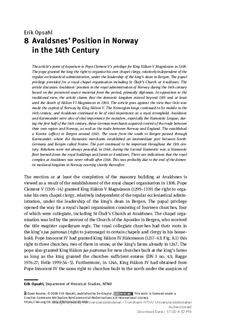| dc.contributor.author | Opsahl, Erik | |
| dc.date.accessioned | 2020-01-14T11:45:35Z | |
| dc.date.available | 2020-01-14T11:45:35Z | |
| dc.date.created | 2020-01-07T17:02:34Z | |
| dc.date.issued | 2020 | |
| dc.identifier.isbn | 978-3-11-042579-6 | |
| dc.identifier.uri | http://hdl.handle.net/11250/2636171 | |
| dc.description.abstract | The article’s point of departure is Pope Clement V’s privilege for King Hákon V Magnússon in 1308. The pope granted the king the right to organise his own chapel clergy, relatively independent of the regular ecclesiastical administration, under the leadership of the king’s dean in Bergen. The papal privilege provided for a royal chapel organisation including St Ólafr’s Church at Avaldsnes. The article discusses Avaldsnes’ position in the royal administration of Norway during the 14th century based on the preserved source material from the period, primarily diplomas. In opposition to the traditional view, the article claims that the domestic kingdom existed beyond 1319 and at least until the death of Hákon VI Magnússon in 1380. The article goes against the view that Oslo was made the capital of Norway by King Hákon V. The Norwegian kings continued to be mobile in the 14th century, and Avaldsnes continued to be of vital importance as a royal stronghold. Avaldsnes and Karmsundet were also of vital importance for outsiders, especially the Hanseatic League; during the first half of the 14th century, these German merchants acquired control of the trade between their own region and Norway, as well as the trade between Norway and England. The established a Kontor (office) in Bergen around 1360. The route from the south to Bergen passed through Karmsundet, where the Hanseatic merchants established an intermediate port between NorthGermany and Bergen called Notow. The port continued to be important throughout the 15th century. Relations were not always peaceful; in 1368, during the Second Hanseatic war, a Hanseatic fleet burned down the royal buildings and farms at Avaldsnes. There are indications that the royal complex at Avaldsnes was never rebuilt after 1368. This was probably due to the end of the domestic medieval kingdom in Norway ocurring shortly thereafter. | nb_NO |
| dc.language.iso | eng | nb_NO |
| dc.publisher | De Gryuter | nb_NO |
| dc.relation.ispartof | Rulership in 1st to 14th century Scandinavia. Royal graves and sites at Avaldsnes and beyond | |
| dc.rights | Attribution-NonCommercial-NoDerivatives 4.0 Internasjonal | * |
| dc.rights.uri | http://creativecommons.org/licenses/by-nc-nd/4.0/deed.no | * |
| dc.title | Avaldsnes' Position in Norway in the 14th Century | nb_NO |
| dc.type | Chapter | nb_NO |
| dc.description.version | publishedVersion | nb_NO |
| dc.subject.nsi | VDP::Nordisk arkeologi: 091 | nb_NO |
| dc.subject.nsi | VDP::Nordic archaeology: 091 | nb_NO |
| dc.source.pagenumber | 517-545 | nb_NO |
| dc.identifier.doi | 10.1515/9783110421101 | |
| dc.identifier.cristin | 1767980 | |
| dc.description.localcode | Open Access. © 2020 Erik Opsahl, published by De Gruyter. This work is licensed under a Creative Commons Attribution-NonCommercial-NoDerivatives 4.0 International License. | nb_NO |
| cristin.unitcode | 194,62,65,0 | |
| cristin.unitname | Institutt for historiske studier | |
| cristin.ispublished | true | |
| cristin.fulltext | original | |
| cristin.qualitycode | 2 | |

